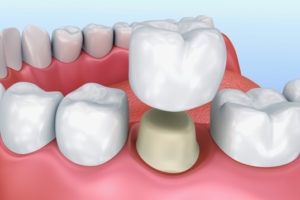Restorations help us keep our biological teeth much longer than we could if damaged teeth were left unprotected. Kaufman Family Dentistry provides beautiful and durable restorations like fillings and dental crowns so that patients can enjoy their natural teeth for as long as possible. We offer white restorations that blend in seamlessly with biologic tooth structure and dental bridges to address minor tooth loss. In addition to beautiful restorations, we provide scaling and root planing to restore gum health and tooth extractions to remove problematic teeth.
Fillings
Fillings are small restorations that fill in the depressions left behind by mild tooth decay. Our practice offers tooth-colored fillings so that our patients can enjoy biocompatible and discreet dental work. Tooth-colored fillings are made from composite resin, a durable compound made of glass and plastic. When applied to teeth, fillings blend in perfectly with neighboring tooth structure to provide a beautiful, undetectable restoration.
Crowns & Bridges
 A dental crown is an extensive, custom-made restoration. Like a cap, a dental crown is used to fit over a tooth’s surface above the gums. This means that a crown will cover the biting surfaces and sides of a tooth. Crowns are beneficial when teeth are badly worn, diseased, and injured. There are numerous materials from which crowns can be made including porcelain, porcelain fused to metal, metal, and zirconium.
A dental crown is an extensive, custom-made restoration. Like a cap, a dental crown is used to fit over a tooth’s surface above the gums. This means that a crown will cover the biting surfaces and sides of a tooth. Crowns are beneficial when teeth are badly worn, diseased, and injured. There are numerous materials from which crowns can be made including porcelain, porcelain fused to metal, metal, and zirconium.
Bridges are a prosthetic made up of custom dental crowns. This type of prosthetic anchors to existing biological teeth on either of its sides. It then fills in the missing structures between teeth with a series of cemented crowns. A bridge could replace up to four consecutive teeth depending on their place in a patient’s arch.
Implant Restorations
Dental implants and the restorations they hold make for excellent replacement teeth. When our patients suffer from tooth loss, we recommend that patients look into whether dental implants are a prosthetic that meets their needs. If they are, our team at Kaufman Family Dentistry will work with your implant specialist to provide a beautiful, lifelike restoration.
Scaling and Root Planing
 Scaling and root planing is a treatment protocol for periodontal therapy. This type of treatment helps control the infection and buildup of debris associated with gum disease. Scaling and root planing removes tartar accumulation on teeth and along the gums. This is done by using handheld instruments to gently remove tartar and debris that builds upon the surfaces of teeth.
Scaling and root planing is a treatment protocol for periodontal therapy. This type of treatment helps control the infection and buildup of debris associated with gum disease. Scaling and root planing removes tartar accumulation on teeth and along the gums. This is done by using handheld instruments to gently remove tartar and debris that builds upon the surfaces of teeth.
After the gums and surfaces of teeth are clean, small instruments are used to smooth the rough surfaces of the roots of teeth. Smoothing the roots of teeth helps to discourage new tartar attachment. Scaling and root planing encourages gingival tissue to reattach to teeth after receding due to irritation. This is a minimally invasive, non-surgical treatment option for various stages of periodontal disease.
Tooth Extractions
Tooth extractions are sometimes a necessity. A tooth extraction might be recommended when a tooth is diseased. For example, a person may have developed an infected tooth that must be removed due to it forming an abscess. Another common reason for extractions is tooth transition. Tooth transition is the period during adolescence where baby teeth are replaced by permanent teeth. If a person’s baby teeth do not fall out fast enough to make room for an emerging permanent tooth, an extraction might be necessary. When performing tooth extractions, our team makes all efforts to ensure our guests feel comfortable and at ease.
Call Kaufman Family Dentistry today to schedule a checkup or consultation.



